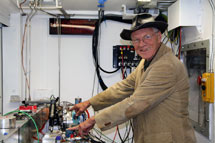
Handy Links
SLAC News Center
SLAC Today
- Subscribe
- Archives: Feb 2006-May 20, 2011
- Archives: May 23, 2011 and later
- Submit Feedback or Story Ideas
- About SLAC Today
SLAC News
Lab News
- Interactions
- Lightsources.org
- ILC NewsLine
- Int'l Science Grid This Week
- Fermilab Today
- Berkeley Lab News
- @brookhaven TODAY
- DOE Pulse
- CERN Courier
- DESY inForm
- US / LHC
SLAC Links
- Emergency
- Safety
- Policy Repository
- Site Entry Form

- Site Maps
- M & O Review
- Computing Status & Calendar
- SLAC Colloquium
- SLACspeak
- SLACspace
- SLAC Logo
- Café Menu
- Flea Market
- Web E-mail
- Marguerite Shuttle
- Discount Commuter Passes
-
Award Reporting Form
- SPIRES
- SciDoc
- Activity Groups
- Library
Stanford
Around the Bay
Tom Hostetler is Still Having Fun
Friends of Tom Hostetler may recognize the moment when he looks you square in the eye, his face focused on yours, and says, "You with me?" With that question, Hostetler checks to see whether his listener is on board as he leads down a path of explanation. From under his weather-beaten leather hat that smells of pipe tobacco, his eyes shine against tan skin. He'll amble through his knowledge of X-ray physics and engineering acquired in 20-plus years working at the Stanford Synchrotron Radiation Lightsource; pass by stories and memories from SLAC history; or just share his laid-back thoughts on life.
It's not surprising to learn that Hostetler studied philosophy before he ever learned physics. His inquisitive nature and somewhat spiritual perspective on life are just as prominent as his physics knowledge. Upon graduation from Stanford University in 1969, he alternated between thoughts of becoming a lawyer or a priest. An internship at SLAC and the woman he married changed those plans. He first worked at SLAC in 1967 as a summer student in Martin Perl's group, studying the rho meson, and then in David Leith's group. In SLAC's first decade, Hostetler recalls meeting Jonathan Dorfan, at the time a staff particle physicist, who would later serve as laboratory director. "He taught me how to eat a pear and have nothing left to throw away," says Hostetler.
After a few years on staff as a mechanic and electrical engineer, Hostetler headed off to seminary before deciding to get married instead. He took work in San Francisco as a general contractor, but in 1986 felt SLAC calling him back. He applied for work at the laboratory; offers came from three different departments. To decide which one to take, Hostetler brought his wife to the campus. "I brought her down to SSRL and she said, 'go with that one, it looks like more fun.' And she was right."
Some 20-odd years later, Hostetler still has fun at his job. With a wide range of responsibilities—including building machine parts in the beam, basic operation and studying the prevalence of ozone in the experimental hutch—Hostetler contributes in many ways to user support at SSRL. Staff members seek him out to build, fix or find any number of necessary parts for the materials science beamlines. Hostetler has worked with a few regular users for as many as 15 years, helping to meet their needs each time they come to SSRL. Currently, he is also investigating a renewed helium recycling plan for the lightsource.
Walking between beam hutches in the warehouse-like Building 120, Hostetler picks up a hunk of metal with a number of detailed parts. An amber tinted window the size of a quarter looks into a sample enclosure, secured on either end by two metal springs. "It's a heater-stretcher," he explains. "They needed a way to warm up a sample and stretch it, so I made this. We've found that heating and stretching the plastics really influences the interatomic spacing of the plastic and changes the properties. You with me?"
Hostetler's three children are grown and out of the house, and last February he became eligible for social security. But when asked about retirement plans, he laughs and says, "They'll carry me out of here feet first. I never get bored. There are a lot of clever people here and I've learned who to find to get my questions answered."
—Calla Cofield
SLAC Today, December 3, 2008
